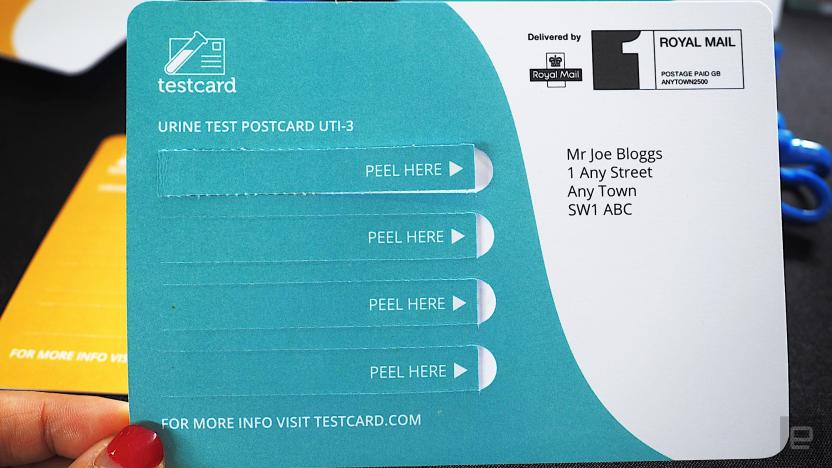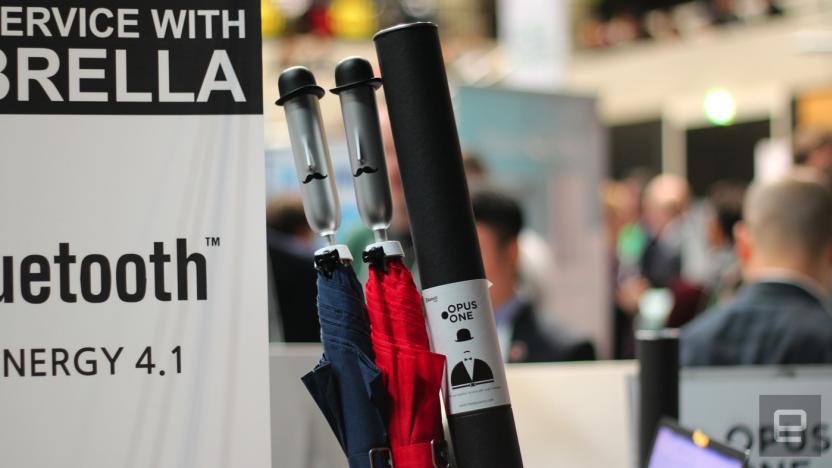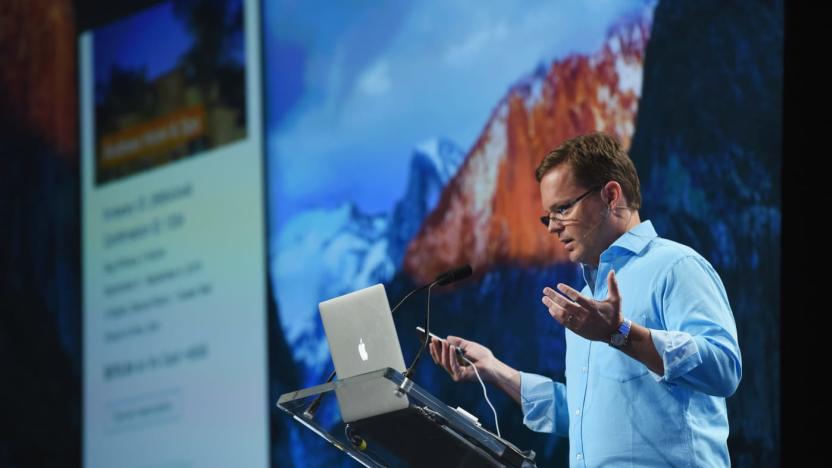TechcrunchDisrupt
Latest

Lockheed's drone challenge: create an AI pilot that beats pro racers
While autonomous drones exist, they're not usually what you'd call speedy when many skilled pilots could beat them in a race. Lockheed Martin and the Drone Racing League want to do better. They're launching an AlphaPilot Innovation Challenge that will encourage the public to develop drone AI that can not only race at high speeds, but win. Competitors will have to build an NVIDIA Jetson-based AI system that can swiftly move through the League's Artificial Intelligence Robot Racing circuit.

Lilu is a pumping bra that promises more breast milk in less time
Breast pump technology have come a long way from the awkward manual tools of old. Now there are smart pumps that can pump out milk as nursing mothers carry on with their everyday lives; one even won our Best of CES award this year for its simple unobtrusive design. Yet, most breast pumps only do one thing: suction. Some doctors and lactation experts also advise to massage the breasts, pressing all around to get the milk out, which can be a tedious task. Lilu, however, is one company that aims to fix this. It's made what it calls the first-ever pumping bra with automated compression, that applies the pressure for you.

Pee on a postcard to determine if you have a UTI
Among the many startups on display at the TechCrunch Disrupt hall in San Francisco this week are companies focused on health and biotech. The products ranged from smart exercise bikes to breast pumps that look like they're from a science-fiction film. One of them, however, stood out from the rest with a large sign that simply read "Take the piss," with the last word in big bold letters. The company is called Testcard, and it claims to tell if you have a urinary tract infection if you pee on the postcard. It's just one of many medtech startups vying for legitimacy in an increasingly crowded field.

Pi can wirelessly charge your phone from a short distance
Despite Apple finally releasing phones with wireless charging, the technology has actually been around for several years. And the fact is, charging via a pad is still kind of a pain -- you can't really use them when they're being charged and you either need a charging pad for every device or one ginormous pad for all of your devices. There have been other companies that promise long-range wireless power before -- Energous' WattUp says it can charge devices up to 15 feet away -- but these products have yet to come to market. A new startup called Pi, however, aims to offer a wireless charging solution that is somewhere in between.

Former Samsung engineers build a smart umbrella
Wouldn't it be great if your umbrella told you if it was going to rain before you left the house each morning? That's the idea behind the Opus One, a(nother) smart brolly that's been designed by a team of former Samsung engineers. The device (for it is not an umbrella now, but a device) connects to your smartphone over Bluetooth and pulls weather reports every morning. When it's time to go out, you simply shake the handle and a light will flash red or green, depending on what's coming.

There's an app for in-flight 'flirting'
AirDates is a new app, currently in testing, that is positioning itself as Tinder for air travel, although it'll work on all forms of public transport. Users are encouraged to post their travel itinerary ahead of time so that they can potentially hook up with other passengers on the same journey. If they're looking for some pre-mile high fun, they can use geolocation while at the airport, or chat with each other in the air. This is achieved using Multipeer WiFi between smartphones, eliminating the need to rely upon the Plane's WiFi network or other connection.

The Eye-Sync system can diagnose concussions in one minute
Concussions are no joke -- just ask Cam Newton -- but a new diagnostic system developed in conjunction with Stanford University could revolutionize the way these head injuries are determined. The Eye-Sync, from the SyncThink company, uses a modified VR headset and custom software running on a consumer tablet to diagnose concussions in just one minute.

JBL's Everest Elite cans let you hear actual reality in VR
Normally when you're tooling around in a virtual world, you want the experience to be as immersive as possible. But there's a downside to being cut off from the outside world -- what if the phone rings or the pizza guy starts knocking or a crazed ax murderer breaks in the back door? Well, if you happen to have a pair of JBL Everest Elite headphones and an HTC Vive, you'll be able to take that call, receive that pizza or head Mr. Choppy off at the stairs. All without taking off your ear cans.

Viv, from Siri's creators, is the virtual assistant of your dreams
Siri made the world aware of the potential of virtual assistants, but several years after its release, it's still a bit basic. Siri can only do certain very specific tasks, and she doesn't play well with third-party services. So for its next product, Viv, the people behind Siri aimed to build a much more capable virtual assistant. And at this point, it looks like it's succeeded, judging from a brief demonstration today at TechCrunch Disrupt in New York City.

Way is the smart skin sensor nobody needs
For a lot of people, devoting their life in a quest to look forever young is probably a bit too much effort, which is why a device like Way exists. Way is a semi-wearable sensor that monitors the moisture levels in your skin and reports that information to your smartphone. In addition, the donut-shaped gizmo sniffs out the local humidity and UV levels, giving you up-to-the-minute information on looking after your skin.

Can a screenplay algorithm save Hollywood?
Hollywood may be full of focus groups and statistical analysts, but deciding which movie to back still comes down to the gut feeling of a cigar-chewing studio mogul. Now, a Belgian startup is hoping that its algorithmic script-reading software can know, with a far greater certainty, if a screenplay is going to be a success or not. ScriptBook is the brainchild of Nadira Azermai, who plans to unleash the software to the public for the first time at next February's Berlin Film Festival.

The shower of the future will save the planet, but at a high price
Aside from building a coal-fired power station, the thing that activates your brain's climate-guilt gland the fastest is taking a luxurious bath. Unfortunately, using a shower isn't that much better for the planet, which is why Dutch startup Hamwells has built the ultimate in eco-washing facilities. The company is showing off its first-generation e-Shower here at TechCrunch Disrupt, and the device does for showers what Dyson did for vacuum cleaners: makes it an object of desire. There's just one downside, and that's how much you're going to have to spend to own one.

Telegram founder knew ISIS was using his service before Paris attacks (updated)
Secure messaging service Telegram announced on Wednesday it had shut down 78 ISIS-related channels since the deadly attacks on Paris and Beirut, alongside a statement saying the company was "disturbed to learn that Telegram's public channels were being used by ISIS to spread their propaganda." This made the situation sound like new information to Telegram -- but that's not the case. At TechCrunch Disrupt in September, Telegram founder Pavel Durov told interviewer Mike Butcher that he knew ISIS used his app (as spotted by The Washington Post). "I don't think we are actually taking part in these activities," Durov said. "I don't think we should be guilty or feel guilty about it." The relevant conversation went down as follows:

CatFi Box is the Google Cardboard of smart cat feeders
Last year, Zillians launched a high-tech cat feeder called Bistro that'll monitor how much food and water your little feline is eating thanks to a smart built-in facial recognition camera. Since then, the company has renamed the product to the CatFi Pro, which is pretty much the same exact thing, except with a different name. But what if you don't have the $199 or so to drop on the CatFi Pro and you still want to keep tabs on kitty's diet? Well, Zillians has just come out with a less-functional but still-workable cardboard alternative called simply CatFi Box, which they showed off at TechCrunch Disrupt in San Francisco this week. Yep, all you need is a spare Android phone, a piece of cardboard and an Exacto knife to make your very own high-tech cardboard cat feeder. Think of it as Google Cardboard but for your cat. And you know, without that whole VR thing.

Security app automatically encrypts your shared files so you don't have to
In this post-PRISM world, basically everyone is worried about privacy (and rightly so!) -- especially when it comes to cloud-based storage. Offloading your files to the likes of Dropbox doesn't come without a share of caveats regarding security, so that's where Places comes in. What sets the startup's service apart from its peers, according to TechCrunch, is local, automatic, end-to-end encryption for your documents and media. There apparently isn't another step you need to take between uploading the video of your toddler's first steps and it being securely locked away. What's more, Places uses your local machine to host offloaded content, relying on its centralized servers only when your PC is otherwise unavailable. And because your digital life is encrypted on the client side, Places claims it doesn't have the key to unlock anything stored on its end should the government or anyone else come knocking. That, of course, is reserved for the intended recipient and no one else.

Equil's Smartpen 2 can transcribe your notes without your tablet's help
The Equil JOT smartpen was a nice evolution on digitally-enhanced writing implements. Much like Livescribe's digitizing pen, it copied all a writer's scribbles to a companion iPad app -- but the JOT didn't need a special notebook to do it. Rather than requiring writers to buy special smartpen-friendly paper, Equil created a sensor that could be attached to any notebook and synced wirelessly with iOS devices. Now that JOT's rebranded successor, the Smartpen 2, doesn't even need to do that.

Monsieur robotic bartender automates mixed drinks with a tap of a finger
While many of us enjoy the pleasure of mixed alcoholic beverages, not everyone wants to take the time to make them ourselves. Perhaps that's why the Raspberry Pi-powered Bartendro cocktail mixing bot proved so popular that it easily reached its $135,000 Kickstarter goal. Yet, the Bartendro's decidedly homespun look might not fly so well in more respectable establishments. Enter the Monsieur, which is a much more elegant solution for lazy lushes everywhere. Monsieur is a "robotic bartender" housed inside a stylish black box, developed by Georgia Tech mates Barry Givens and Eric Williams after Givens got tired of waiting for a mixed drink at a bar. The duo spent months working to make sure it poured just the right measurements per drink (that must've been fun to test) and making other refinements that resulted in the machine you see above. The Monsieur comes in either eight or 12 bottle configurations, and you can find out which alcohol or mixer to put in which slot by following the instructions on the machine. It has a built-in recipe library, customizable drink profiles and it even creates a grocery list for you. Right now the machine uses an Android tablet to drive it, but they hope to have a more integrated solution when it comes to market. There's also a corresponding mobile app that offers recipe ideas. The Monsieur is currently being marketed as part of bottle service at high-end bars and at sporting events. All the staff would need to do is roll the box into a room and let customers order what they want; the computer will keep track of the orders and bill them when they're done. Givens and Williams don't rule out the possibility of a consumer version, but that's not in the cards just yet. Until then, check out the source link for more info or hit up the via to see their presentation at TechCrunch Disrupt.

Dryft: a software keyboard that follows fingertips to improve touch typing on tablets
You've seen them on planes, in coffee shops, maybe even at the office: tablets tethered to Bluetooth keyboards. Those users pecking away at hardware keys because using their slate's software grid is nothing more than an exercise in futility. Dryft is a soft keyboard built by Swype co-founder Randy Mardsen that aims to change that. You see, most of us are touch-typers and rest our hands on the 'home row' of keys to tell our fingers where to reach all the other letters. But, the smooth surface of tablet displays prevents our phalanges from finding the proper orientation. Dryft eliminates that problem by automagically positioning the keys beneath your fingertips wherever they may be, and by allowing users to rest their hands on the screen. Dryft can do this because it doesn't rely solely on the touch sensors embedded in the screen, it also uses accelerometer data to determine if your fingertips are taking a break or are pecking away with purpose. Because of its reliance upon high fidelity signals from the accelerometer to work well, Dryft needs low-level access to that sensor's data -- and that means we won't be seeing a Dryft download in any app store. Instead, Mardsen is taking the same route as he did with Swype, and is planning to license Dryft for use on Windows Phone, Android and iOS. Plus, developers will be able to integrate Dryft in individual apps thanks to a forthcoming SDK. Want to see Dryft in action? A video awaits after the break.

Mhoto analyzes any image, gives it an appropriate, customized soundtrack
When we see a picture of the Notorious B.I.G., the hook from Hypnotize starts streaming in our heads. Imagine if you will, an app that analyzes your picture and creates a soundtrack suited to you. Mhoto does just that, and it can synthesize an appropriate tune for any digital photograph. Mhoto's magic comes courtesy of some patent pending technology that analyzes a picture's saturation, brightness and contrast levels and uses that information to create music tailored to fit the feel of the photo -- and the company's working on a way to integrate facial recognition into the mix to make mood based music, too. Users also can choose what musical genre they want the generated tunes to come from (Hip Hop, Rock, Pop, etc.). The best part is, the heavy lifting is done in Amazon's cloud, so Mhoto can work on any device with a data connection, even a featurephone.

Cota by Ossia hopes to charge your phone wirelessly, no contact required
We've all heard of wireless charging before, but most solutions still require your phone to come in touch with a base station. Well, Cota is a technology that aims to power your mobile device completely wirelessly -- without any physical contact at all. Hatem Zeine, a physicist and CEO of Ossia Inc, demonstrated the technology on stage at TechCrunch Disrupt when he successfully charged his iPhone when plugged with a Cota prototype, seen above, while holding it several feet away from a charging station. It all seems like voodoo, but the secret lies in sending a magnetic charge over the same 2.4GHz spectrum that WiFi and Bluetooth already use. If you're concerned about safety, Zeine assures us that only one watt of power is transmitted -- that's a third of what cell phones already transmit. Line of sight isn't required, and Zeine claims that one station can power multiple devices at once. Just like a WiFi hotspot, you can set it so that it only works with certain devices or simply open it up so that power is available to all Cota-enabled handsets within range, which is around 30 feet.








